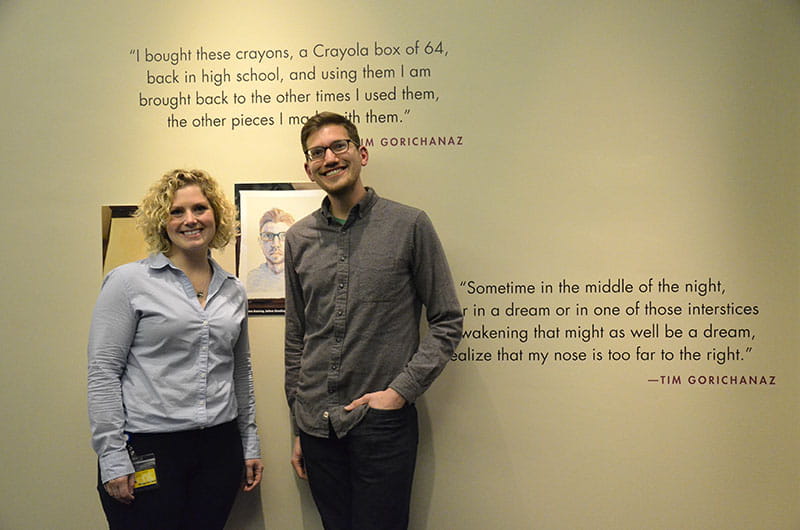New Rincliffe Gallery Exhibition Demonstrates the Artistic Process

Tim Gorichanaz and Lynn Clouser at the Stories of Self-Portraits opening event on April 5.
Visitors to an art exhibition are often invited to hypothesize their own interpretation of a piece. Rarely, however, are they given a birds-eye view into the physical and mental process that the artist used to arrive at their final product.
With his doctoral thesis, a product of which is the Stories of Self-Portraits exhibition now open in Drexel University’s Rincliffe Gallery through July 27, Tim Gorichanaz, an information science PhD candidate in the College of Computing & Informatics, wanted to take the assumptions and guess work out of each artists’ process as a means of showcasing how art and artistic creation teaches us about ourselves, about each other and about our society.
“I’m really interested in an area of information science called document theory. It’s an area looking at all different kinds of documents, and seeing what they have in common and how they’re different,” Gorichanaz said. “A lot of that focuses on textual things, and a lot of it focuses on new digital stuff. So one of the things is I wanted to look at was something non-verbal, so a visual type of document. I’ve always been interested in the arts, and thinking about art as an information product. What can we learn from art? Not just looking at it as something pretty, but something that shows something about reality.”
Gorichanaz called himself an art “hobbyist,” and enjoyed the opportunity to unite his childhood interest in art with his doctoral research. A total of eight artists are featured in the exhibition, including Gorichanaz’s own piece — a crayons-on-paper drawing blended using turpentine. Whether through his friend network or exhaustive Google searches for local artists, Gorichanaz found each artist and then studied their process by sitting in on a number of their work sessions, having them answer a series of questions after each one.
In the exhibition, each finished piece is also displayed alongside photos which illustrate the artist’s process, as well as quotes and a poem written by Gorichanaz, but derived from his artist interviews.
“I really feel like this was a collaborative project,” he said. “Like, it’s their work and they’re doing it, but I kind of helped stir it up a little bit.”
Brianna Ballinghoff, a University of the Arts student studying illustration who created an acrylic-on-canvas self-portrait for Gorichanaz’s thesis, said she was happy partaking in the project, which also became a way for her to promote her art. She added that people will likely enjoy how the exhibition showcases the fact that there is more than one way to approach a self-portrait, even beyond medium.
“it’s interesting to see someone care about the process, rather than the finished piece,” Ballinghoff said of Gorichanaz’s concept.
At first, Gorichanaz said he hadn’t even considered doing an exhibition as part of his doctoral project.
“There is a new area of research called arts-related research which kind of uses art to ask academic questions. So it could be in sociology or psychology, or in my case information science, and a huge part of arts-related research is engaging with the public,” he said. “So I was kind of thinking about that, and one of my participants, Justin [Tyner], who did the stained glass piece, he said, ‘Hey, why don’t you do an exhibition?’ And I was like, ‘Well duh! That’s a good idea.’”
Gorichanaz said his obvious first step to putting on an exhibition was to check with Drexel. He reached out to Lynn Clouser, director of The Drexel Collection, in March 2017. She reported that though exhibitions like this are usually booked two years in advance, there was a fortuitous opening in the Rincliffe Gallery for this spring. The exhibition was also fully funded through The Drexel Collection’s annual exhibition budget.
“It was a hole in the perfect spot,” Gorichanaz said. “All of the pieces would be done, and it was in tandem with my dissertation defense and my graduation. So it was, like, weirdly perfect.”
Clouser said it was a smooth process working with Gorichanaz to get the exhibition up and running. She added that this exhibition is rich with information but that viewers can approach it how they want, and take away from it what they will.
“It’s a pretty dense topic, with a range of information,” Clouser said. “Tim boiled it all down into a digestible and accessible exhibition where people can simply enjoy the artwork, or they can take in the wealth of information that each piece conveys.”
Across from the pieces studied in Gorichanaz’s thesis, several self-portraits from The Drexel Collection were also integrated into the exhibition. Gorichanaz said he hopes it’s interesting for patrons to see these pieces juxtaposed with the process-oriented material in order for them to muse what those artists’ processes might have been to arrive at their self-portraits.
“It’s interesting to see how the artists depict themselves, what they’re wearing, what they may be thinking,” he said. “All of The Drexel Collection pieces are very representational. One of the things that came up in my exhibition is that there are kind of two ways to represent yourself — one that is in your outward appearance, and one that’s in your style, your artistic style.”
For Gorichanaz, the exhibition is a great way to celebrate the near conclusion of his thesis project, which he’s been working on for most of his four-year doctoral studies. In May, Gorichanaz will defend his thesis, and “barring any mishaps,” graduate in June.
The Rincliffe Gallery is located on the third floor in the Main Building, 3141 Chestnut Street. The exhibition is free and open to the public. Find out more about the exhibition at selfportraiture.info.
Drexel News is produced by
University Marketing and Communications.

